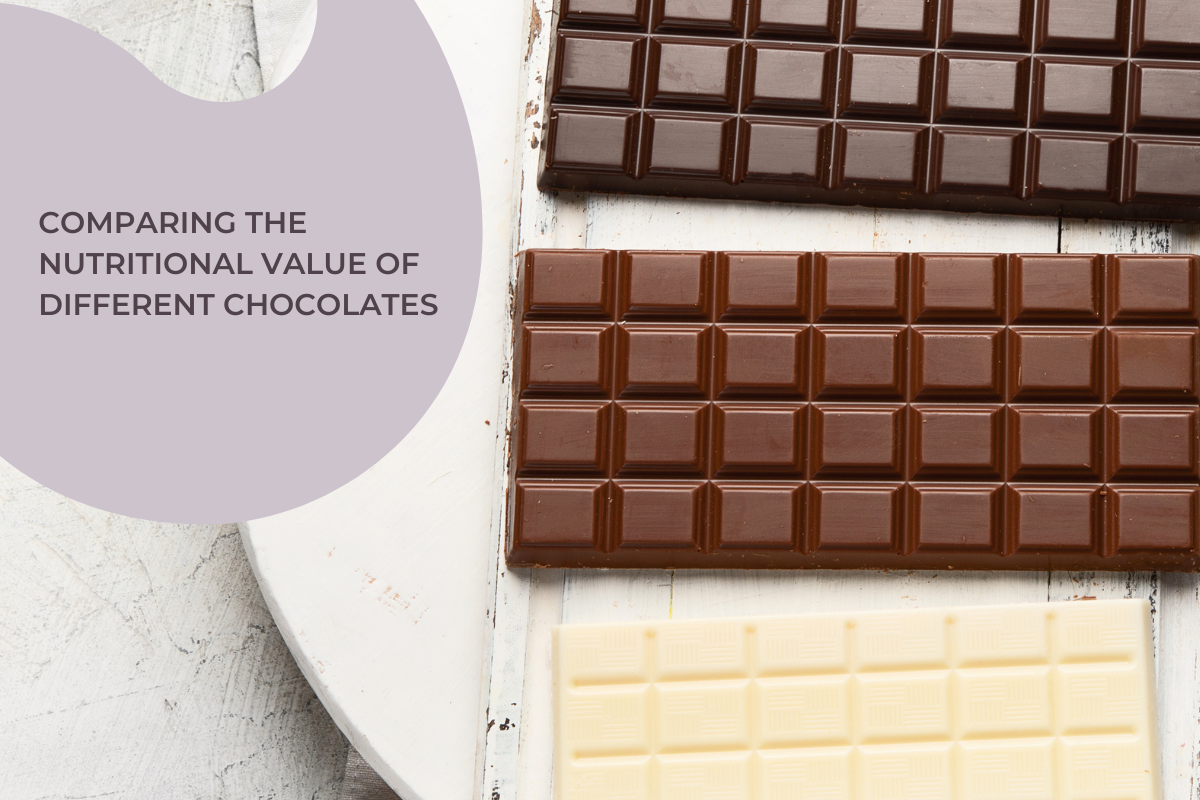Chocolate is a favorite treat for many, but not all chocolates are the same when it comes to your health. From dark and milk to white and ruby, each type has its own flavor and nutritional benefits. Knowing the nutritional value of different chocolates can help you make better choices when you choose to indulge. In this article, we’ll compare the nutritional content of various chocolate types, looking at their ingredients, health benefits, and potential downsides. If you want to be more aware about what you eat, this chocolate health guide will provide insights to help you enjoy every bite while keeping your body in mind.
Nutritional value of chocolate
The nutritional value of chocolate can vary significantly depending on the type of chocolate and its ingredients. Here’s a general overview of the nutritional content for several different types of chocolate, based on a standard serving size of about 1 ounce (28 grams):
Dark chocolate (100% Cocoa)
- Calories: 160-170
- Fat: 14-16 grams
- Saturated Fat: 8-10 grams
- Carbohydrates: 12-13 grams
- Sugars: 0 grams
- Fiber: 3-5 grams
- Protein: 3 grams
- Vitamins & Minerals: Rich in iron, magnesium, copper, and manganese; also contains antioxidants.
Dark chocolate (70-85% Cocoa)
- Calories: 170-190
- Fat: 12-15 grams
- Saturated Fat: 7-9 grams
- Carbohydrates: 13-16 grams
- Sugars: 4-8 grams
- Fiber: 3-4 grams
- Protein: 2-3 grams
- Vitamins & Minerals: Rich in iron, magnesium, copper, and manganese; also contains antioxidants.
Milk chocolate
- Calories: 150-170
- Fat: 8-10 grams
- Saturated Fat: 5-6 grams
- Carbohydrates: 20-24 grams
- Sugars: 18-20 grams
- Fiber: 1-2 grams
- Protein: 2-3 grams
- Vitamins & Minerals: Contains calcium and some antioxidants, but less than dark chocolate.
White chocolate
- Calories: 150-170
- Fat: 8-10 grams
- Saturated Fat: 5-6 grams
- Carbohydrates: 22-24 grams
- Sugars: 20-22 grams
- Fiber: 0 grams
- Protein: 1-2 grams
- Vitamins & Minerals: Lacks cocoa solids, so it has minimal antioxidants; contains some calcium.
Ruby chocolate
- Calories: 150-170
- Fat: 8-10 grams
- Saturated Fat: 5-6 grams
- Carbohydrates: 22-24 grams
- Sugars: 20-22 grams
- Fiber: 0-1 gram
- Protein: 1-2 grams
- Vitamins & Minerals: Similar to white chocolate, with minimal antioxidants (even less than milk chocolate).
Key nutritional components in chocolate
Cocoa solids are the key ingredient in dark and milk chocolate, packed with flavonoids—antioxidants that promote heart health and improve circulation. Chocolate also contains cocoa butter, which provides healthy, vegetable fats. While dark chocolate has a higher fat content, these are mostly beneficial monounsaturated and saturated fats that can be good for you in moderation. To learn more about chocolate’s health benefits, check out our article on the 10 Benefits of Dark Chocolate.
The sugar content varies by type, with dark chocolate usually having less sugar than milk and white chocolate (and no sugar in the case of 100% dark). It’s important to keep an eye on your sugar intake to avoid health problems, so understanding how to read your chocolate label is key to knowing what you are putting into your body.
Dark chocolate also contains dietary fiber, which aids digestion and helps you feel full, while milk and white chocolate have less fiber. Although chocolate isn’t a major source of protein, it does contribute small amounts to your diet. Additionally, it is packed with essential vitamins and minerals, including iron for blood health, magnesium for muscle and nerve function, copper for iron metabolism and connective tissues, and manganese for bone health.
Health benefits and risks of different chocolates
Dark chocolate:
- High caloric content: While it offers health benefits, dark chocolate is calorie-dense, and overconsumption can lead to weight gain.
- Stimulant content: Dark chocolate contains theobromine and some caffeine, which can cause jitters or insomnia if consumed in large amounts.
Milk chocolate:
- High Sugar Content: Milk chocolate typically has a higher sugar content than dark chocolate, which can lead to weight gain and increase the risk of diabetes and heart disease, if consumed excessively.
- Less Nutritional Value: Milk chocolate often contains fewer beneficial compounds compared to dark chocolate, meaning the health benefits are less pronounced.
White and ruby chocolate:
- Lacks Nutrients: White chocolate contains no cocoa solids, which means it lacks the beneficial antioxidants found in dark and milk chocolates. Ruby chocolate contains minimal cocoa solids and is nutritionally closer to a white chocolate than a milk chocolate.
- High in Sugar and Fat: White and ruby chocolate are typically high in sugar and fat, leading to potential health risks like weight gain and increased blood sugar levels when eaten in excess.
We hope that you enjoyed this information about the health benefits of different types of chocolate. Know your chocolate and eat healthy!
For more great articles and recipes, check out the rest of our CocoTerra blog.
If you have any questions or comments, feel free to contact us through our social media channels. We are @cocoterra_co on Instagram and Pinterest and @cocoterraco on X (aka Twitter) and Facebook.








